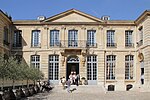Varenne (Paris Métro)
Paris Métro line 13Paris Métro stations in the 7th arrondissement of ParisRailway stations in France opened in 1923

Varenne (French pronunciation: [vaʁɛn]) is a station on Line 13 of the Paris Métro. Located in the 7th arrondissement, it is named after the Rue de Varenne.
Excerpt from the Wikipedia article Varenne (Paris Métro) (License: CC BY-SA 3.0, Authors, Images).Varenne (Paris Métro)
Boulevard des Invalides, Paris Quartier des Invalides (Paris)
Geographical coordinates (GPS) Address Nearby Places Show on map
Geographical coordinates (GPS)
| Latitude | Longitude |
|---|---|
| N 48.856238 ° | E 2.314921 ° |
Address
Boulevard des Invalides
Boulevard des Invalides
75007 Paris, Quartier des Invalides (Paris)
Ile-de-France, France
Open on Google Maps










